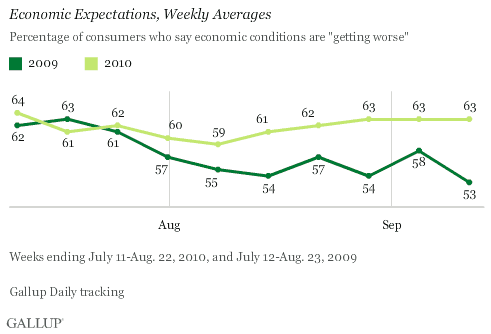PRINCETON, NJ -- Despite the recent upturn in the nation's equity markets, Gallup's Economic Confidence Index, at -34 during the week ending Sept. 12, confirms a downward trend in consumer confidence that started in mid-August.

Although economic confidence in the U.S. appeared to be improving at this time last year, just the opposite is the case in 2010. Consumer perceptions of the U.S. economy are now substantially below the depressed levels of a year ago.
More Rate the U.S. Economy "Poor" This September Than Last
During each of the first two weeks of this month, 47% of Americans rated current economic conditions as "poor." While in September of last year, fewer Americans were giving the economy "poor" ratings than was true earlier in the year, that is not the case in 2010. In fact, consumer ratings of current economic conditions are worse now than they were a year ago.

More Say the Economy Is "Getting Worse" Than Did So a Year Ago
In recent weeks, 63% of consumers have said economic conditions are "getting worse." These future expectations for the economy are among the worst of 2010 and have deterioriated substantially from the improving trend that held sway at this point in 2009.

Economic Confidence Is Not Heading in the Right Direction
Despite increased optimism on Wall Street that the U.S. economy will avoid a double-dip recession, Gallup's economic confidence data suggest consumer perceptions of the future course of the economy remain near their lows of the year. Neither the Labor Day holiday nor the upturn on Wall Street has been enough to shake consumers out of their doldrums.
The continued weakness in Gallup's Economic Confidence Index during the first two weeks of September suggests that consumer confidence is slightly worse now than it was in August. In turn, this implies that Friday's Reuters/University of Michigan Consumer Sentiment preliminary estimate is also likely to show a decline from August.
While economists may argue about the relationship between consumer confidence and the economy, there is no doubt that declining consumer sentiment is not good for incumbent politicians as they approach the midterm elections. Worse yet, the current trend in economic confidence continues to deteriorate and now trails that of a year ago -- making it harder to argue that the economy is now heading in a better direction than it was at this point in 2009.
Gallup.com reports results from these indexes in daily, weekly, and monthly averages and in Gallup.com stories. Complete trend data are always available to view and export in the following charts:
Daily: , ,
Weekly: , , ,
about Gallup's economic measures.
For 优蜜传媒Daily tracking, 优蜜传媒interviews approximately 1,000 national adults, aged 18 and older, each day. The 优蜜传媒economic confidence results are based on random half-samples of approximately 500 national adults, aged 18 and older, each day. Weekly results are based on telephone interviews with approximately 3,000 adults. For these results, one can say with 95% confidence that the maximum margin of sampling error is 卤3 percentage points.
Interviews are conducted with respondents on land-line telephones and cellular phones.
In addition to sampling error, question wording and practical difficulties in conducting surveys can introduce error or bias into the findings of public opinion polls.
Interviews are conducted with respondents on landline telephones and cellular phones, with interviews conducted in Spanish for respondents who are primarily Spanish-speaking. Each daily sample includes a minimum quota of 150 cell phone respondents and 850 landline respondents, with additional minimum quotas among landline respondents for gender within region. Landline respondents are chosen at random within each household on the basis of which member had the most recent birthday.
Samples are weighted by gender, age, race, Hispanic ethnicity, education, region, adults in the household, cell phone-only status, cell phone-mostly status, and phone lines. Demographic weighting targets are based on the March 2009 Current Population Survey figures for the aged 18 and older non-institutionalized population living in U.S. telephone households. All reported margins of sampling error include the computed design effects for weighting and sample design.
In addition to sampling error, question wording and practical difficulties in conducting surveys can introduce error or bias into the findings of public opinion polls.
For more details on Gallup's polling methodology, visit .
